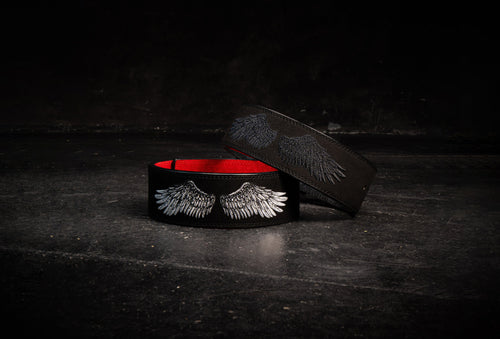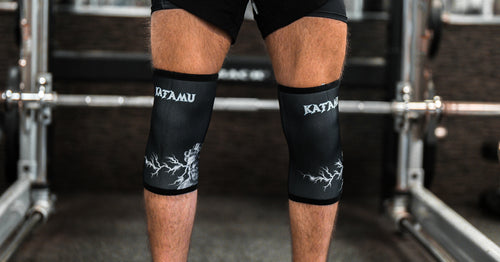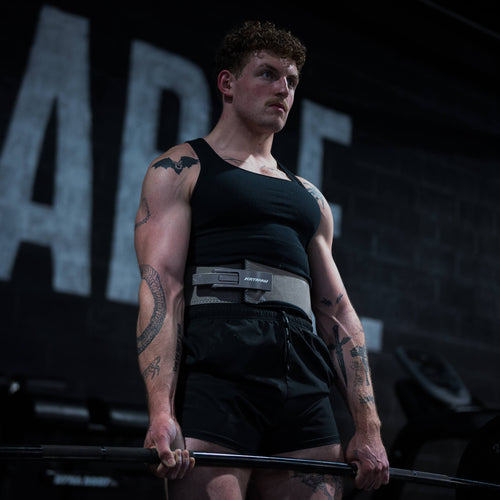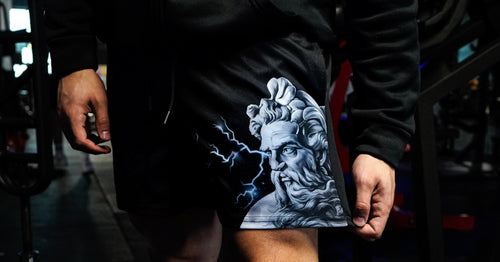Are you serious about lifting in 2025? The right support can mean the difference between progress and painful setbacks. As weight training continues to surge in popularity, choosing the correct gym belt weight is more important than ever for safety and performance. This guide is designed to help you confidently select the best gym belt weight for your goals, whether you’re a beginner or a seasoned athlete. We’ll break down belt types, weight recommendations, key factors, and expert tips. Ready to maximize your lifts and protect your body? Dive in for the complete guide.
Understanding Gym Belt Types and Their Purpose
A gym belt is a staple in any serious lifter’s toolkit. Its main job is to support your core, stabilize your spine, and reduce injury risk when you’re moving heavy weights. In 2025, the right gym belt weight and style can be the difference between safe, powerful lifts and setbacks that stall your progress.
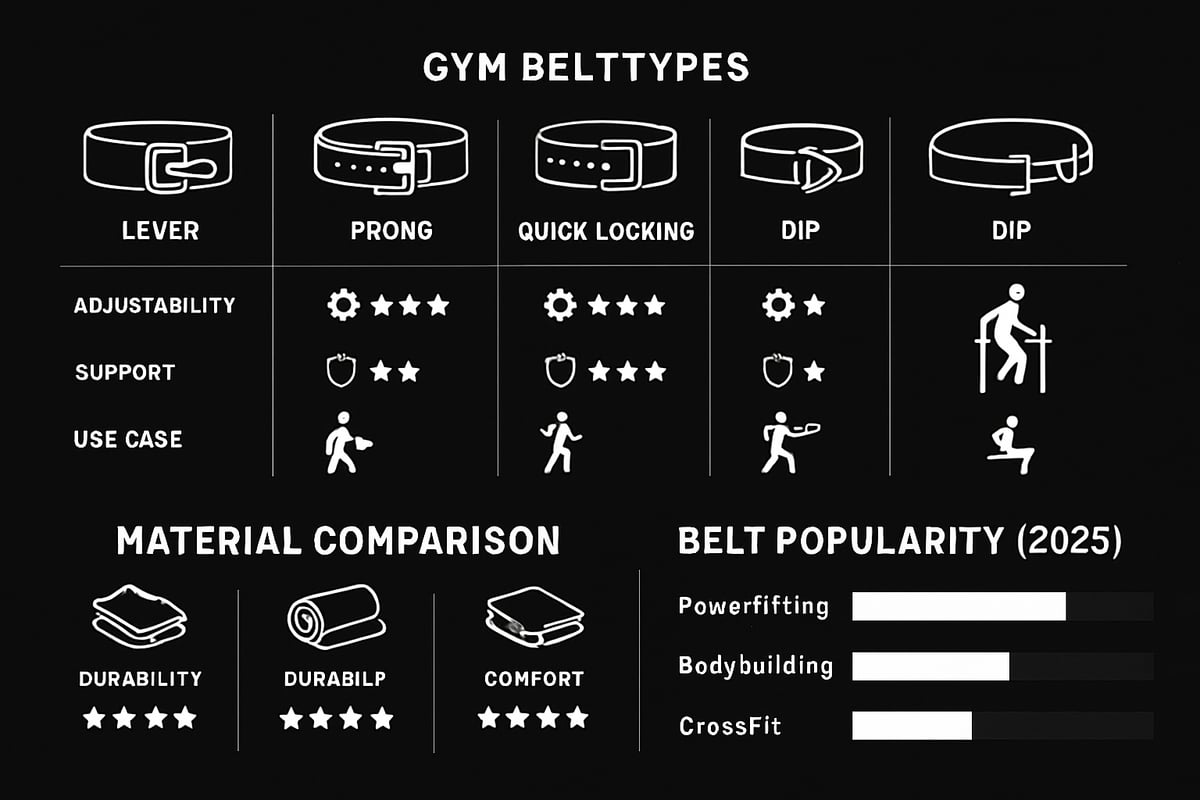
What Is a Gym Belt?
A gym belt wraps around your midsection, providing extra support during heavy lifts like squats and deadlifts. By increasing intra-abdominal pressure, a gym belt weight helps keep your spine aligned and core tight. This simple tool is trusted by athletes at every level.
Main Types of Gym Belts
There are four main types of gym belts, each with unique advantages. Lever belts are known for their quick, secure closure and rock-solid stability, making them a favorite for powerlifters pushing maximal loads. Prong belts, available in single or double prong versions, offer classic adjustability and are popular for both strength and bodybuilding routines. Quick-locking belts use a fast-release buckle, ideal for CrossFit or Olympic lifting where speed matters. Dip belts, designed to add weight for bodyweight exercises, are a must for advanced calisthenics.
For a deeper dive into the differences and best uses for each belt, check out this comprehensive guide on the types of weightlifting belts and their uses.
Material Choices and Comfort
Choosing the right material is just as important as finding the correct gym belt weight. Leather belts are the gold standard for stability and durability, perfect for heavy lifters who need maximum support. Suede belts offer a softer touch and good grip, while nylon belts are lightweight, flexible, and comfortable for dynamic movements. Your choice of material affects not only support but also comfort and longevity.
Evolution and Trends for 2025
In recent years, gym belts have evolved rapidly. Lever belts have surged in popularity among competitive powerlifters, thanks to their unmatched stability and ease of use. Quick-locking belts are gaining traction in the functional fitness community, especially for Olympic lifts that require fast transitions. New belt designs now feature custom patterns, eco-friendly materials, and improved adjustability, reflecting the diverse needs of today’s lifters.
Data shows lever belts remain the top choice for maximal lifts, while quick-locking belts see the most growth in hybrid and CrossFit gyms. These trends highlight the growing awareness of how gym belt weight and style influence both safety and performance.
Choosing the Best Gym Belt Weight
Selecting your ideal gym belt weight is about more than just thickness. It’s a mix of your training style, body type, and comfort preferences. A powerlifter may favor a thick, stiff lever belt for record-breaking deadlifts, while a CrossFitter might choose a flexible, quick-locking belt for varied workouts. Understanding the purpose and design of each belt type ensures you get the support you need, when you need it.
No matter your experience level, the right gym belt weight will help you train with confidence, protect your body, and reach new heights in 2025.
Key Factors to Consider When Choosing Gym Belt Weight
Choosing the right gym belt weight requires a thoughtful approach. Each factor, from thickness and width to fit and your training goals, plays a crucial role in both your comfort and performance. Let’s break down what you need to know before making your decision.
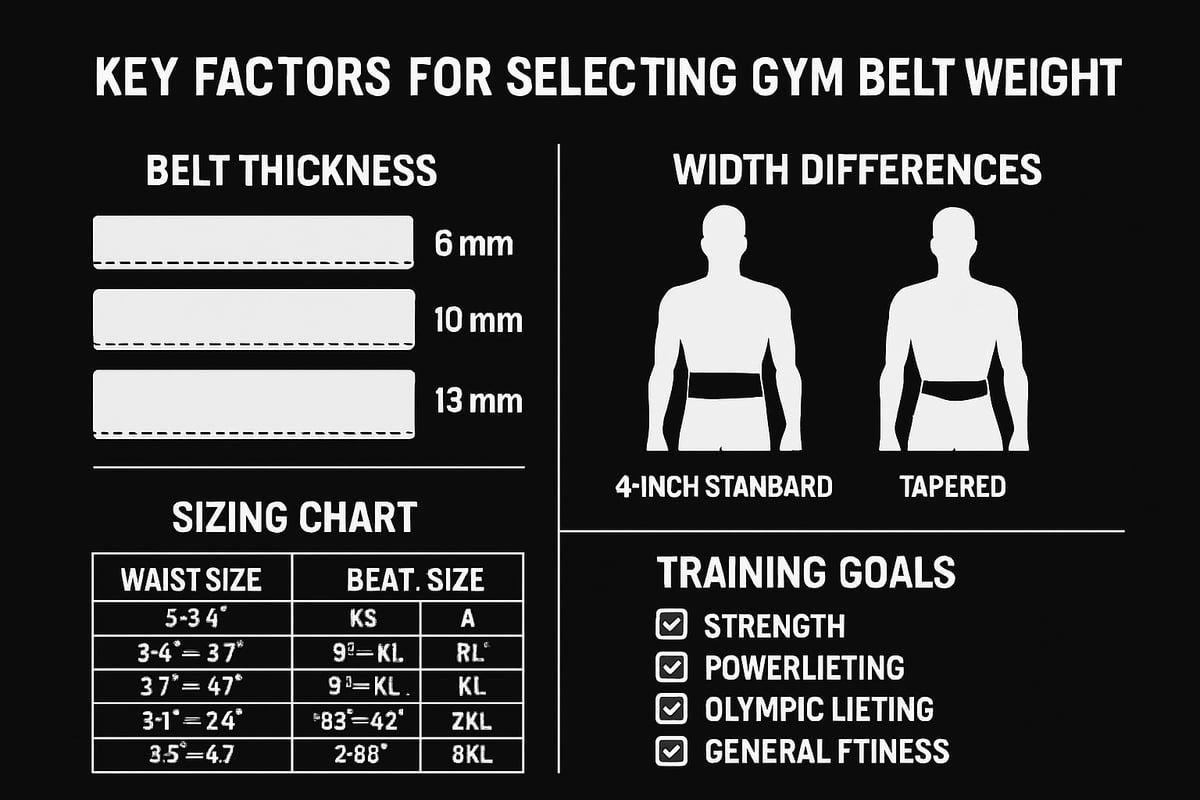
Why Thickness and Width Matter
The thickness and width of your gym belt weight are not just numbers, they are the backbone of support and comfort. Thicker belts, like the 13mm, provide maximum rigidity, making them popular for powerlifting and heavy squats. A 10mm belt is a versatile option, balancing support with flexibility, and is often chosen by intermediate lifters or those who switch between strength and functional training. Lighter, 6mm belts offer greater mobility, which can be ideal for dynamic movements or beginners.
Width also matters. Most belts come in a standard 4-inch width, which offers consistent support for the lower back and core. Tapered belts, which are narrower in the front, can be more comfortable for smaller frames or those doing Olympic lifts where mobility is key.
Comparing Common Gym Belt Weights
Let’s look at how gym belt weight varies by thickness and what that means for you:
| Thickness | Typical Use | Support Level | Mobility |
|---|---|---|---|
| 6mm | CrossFit, beginners | Light | High |
| 10mm | General strength | Moderate | Moderate |
| 13mm | Powerlifting, max | Maximum | Lower |
A 6mm gym belt weight is light and flexible, perfect for learning proper technique. The 10mm option is the all-rounder, giving you a solid mix of support and comfort. For those chasing personal records, the 13mm delivers the highest level of stabilization but can feel stiff for some users.
Fit, Sizing, and Adjustability
A crucial factor in gym belt weight selection is how well the belt fits your body. The right size ensures the belt provides even pressure around your midsection, boosting stability without discomfort. Always measure your waist at the navel to find your true lifting belt size, as this may differ from pant size.
Adjustability is just as important. Prong and lever belts offer different levels of micro-adjustment, while quick-locking belts are easy to put on and take off. For a detailed guide on sizing and fit, check out the Weightlifting Belt Sizes Guide.
Matching Belt to Training Goals and Experience
Your gym belt weight should support your specific goals. If you focus on strength or powerlifting, a thicker, stiffer belt maximizes intra-abdominal pressure for heavy lifts. For Olympic lifting or CrossFit, a lighter and more flexible belt allows for speed and movement. Beginners benefit from a lighter belt to master bracing and technique before moving up in thickness.
Experience level also influences your choice. Advanced lifters often gravitate towards 13mm belts, while those newer to lifting may find 6mm or 10mm more comfortable and less restrictive.
Industry Standards and Competition Rules
When considering gym belt weight, don’t overlook industry guidelines. Organizations like the IPF and USPA set maximum thickness (13mm) and width (4 inches) for competition belts. These standards ensure a level playing field and can influence what belt you purchase if you plan to compete.
Always check the rules of your federation before buying a belt. For recreational lifters, these specs can be a helpful benchmark for quality and durability.
Step-by-Step Guide: How to Choose the Right Gym Belt Weight in 2025
Choosing the right gym belt weight in 2025 can feel overwhelming with so many options on the market. Whether you are a powerlifter, CrossFit enthusiast, or just starting your fitness journey, following a structured approach will help you find the perfect belt for your needs. This step-by-step guide will break down the process, ensuring you make an informed, confident choice.
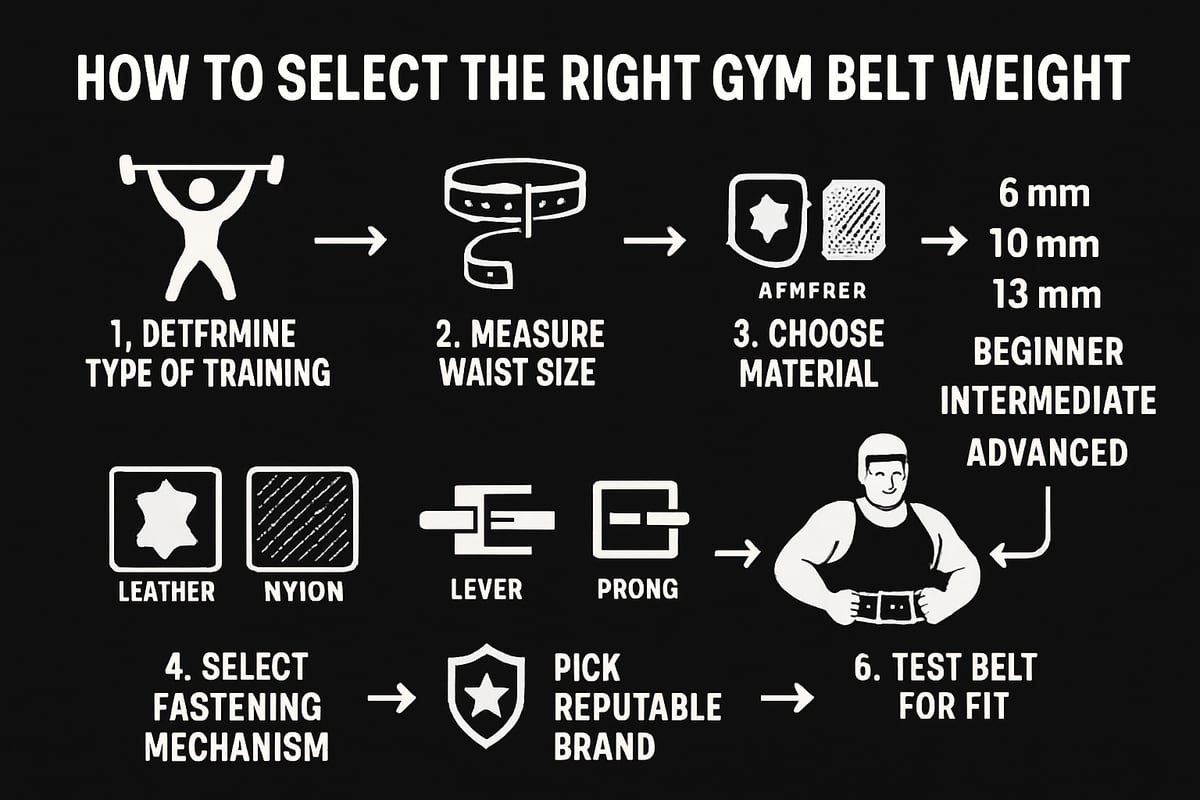
Step 1: Assess Your Training Discipline and Goals
Start by identifying your primary training discipline. Are you focused on powerlifting, bodybuilding, Olympic lifting, CrossFit, or general fitness? Each style has unique demands that will impact your ideal gym belt weight.
Powerlifters often need a stiffer, thicker belt for maximum stability during heavy squats and deadlifts. Olympic lifters and CrossFit athletes benefit from more flexible belts that allow dynamic movement. If you are training for general fitness, a versatile belt with moderate support is usually best.
Consider your specific goals, such as building strength, improving technique, or increasing mobility. Matching your gym belt weight to your discipline ensures optimal support, reduces injury risk, and enhances your overall progress.
Step 2: Measure and Match Belt Size to Your Body
Accurate sizing is crucial for comfort and effectiveness. Use a flexible tape measure to find your waist size at the level where you plan to wear the belt, typically just above the hip bones.
Next, consider belt width. Standard 4-inch belts offer broad support for most lifters, while tapered belts provide comfort for shorter torsos or smaller frames. Ensure the belt covers your core without digging into your ribs or hips.
Common sizing mistakes include using pant size instead of waist measurement or ignoring the impact of torso length. Refer to manufacturer sizing charts and, if possible, try on belts before buying to guarantee a snug, supportive fit for your chosen gym belt weight.
| Waist Size (inches) | Belt Size (manufacturer) |
|---|---|
| 26-32 | Small |
| 32-38 | Medium |
| 38-44 | Large |
Step 3: Select the Appropriate Thickness and Material
Thickness and material are key factors in gym belt weight selection. Standard options include 6mm, 10mm, and 13mm belts. A 6mm belt offers flexibility and is great for beginners or those prioritizing mobility. The 10mm belt is a versatile choice, providing a balance of support and comfort for most lifters. A 13mm belt delivers maximal rigidity, preferred by advanced powerlifters for heavy lifts.
Materials also matter. Leather belts provide unmatched durability and support, while suede offers a softer feel. Nylon belts are lightweight and flexible, well-suited for dynamic movements or Olympic lifts.
For a deeper dive into how thickness, width, and material impact your choice, check out this guide on choosing the right weightlifting belt. Matching thickness and material to your training style ensures your gym belt weight delivers the support you need.
Step 4: Consider Adjustability and Fastening Mechanisms
The fastening system influences both comfort and performance. Lever belts are easy to tighten and release quickly, making them popular for powerlifting. Prong belts, available in single or double prong versions, offer precise adjustability and are a staple for many lifters.
Quick-locking (Velcro) belts provide fast adjustments mid-workout, ideal for CrossFit or Olympic lifting sessions. Evaluate which mechanism aligns with your training and how often you change belt tightness during workouts.
Consider maintenance and durability, too. Levers may require occasional tightening, while Velcro can wear out over time. Select a fastening style that supports your gym belt weight needs and fits your routine.
Step 5: Evaluate Brand Reputation and Warranty
Not all belts are created equal. Choose a reputable brand with a track record of quality and customer service. Look for clear warranty terms, easy return policies, and responsive support.
Read customer reviews to gauge real-world performance and satisfaction. Brands that invest in premium materials and craftsmanship typically offer longer-lasting products, maximizing the value of your gym belt weight investment.
A reliable brand will also provide detailed sizing guides and after-sales support, helping you resolve any issues that arise with your belt.
Step 6: Test and Adjust for Comfort and Performance
Once you have your belt, test it during various lifts—squats, deadlifts, overhead presses—to ensure it delivers the expected support. Take note of how the gym belt weight feels during both light and heavy sets.
Leather belts may require a break-in period. Wear the belt for short sessions initially, gradually increasing use as it molds to your body. Adjust the fit as needed to maintain comfort and stability.
Track your performance and comfort over several weeks. If you experience pinching, slipping, or discomfort, revisit the earlier steps to see if adjustments or a different gym belt weight might be better suited to your needs.
Gym Belt Weight Recommendations by User Profile
Choosing the right gym belt weight is crucial for maximizing both performance and safety. Your experience level, goals, and body type all play a role in determining the best option. Use the table below for a quick comparison, then read on for tailored advice.
| User Profile | Recommended Gym Belt Weight | Key Features |
|---|---|---|
| Beginners | 6mm–10mm | Flexibility, Comfort |
| Intermediate Lifters | 10mm | Support, Versatility |
| Advanced/Competitors | 13mm | Max Support, Stiffness |
| Women, Youth, Masters | 6mm–10mm (tapered optional) | Fit, Comfort, Flexibility |
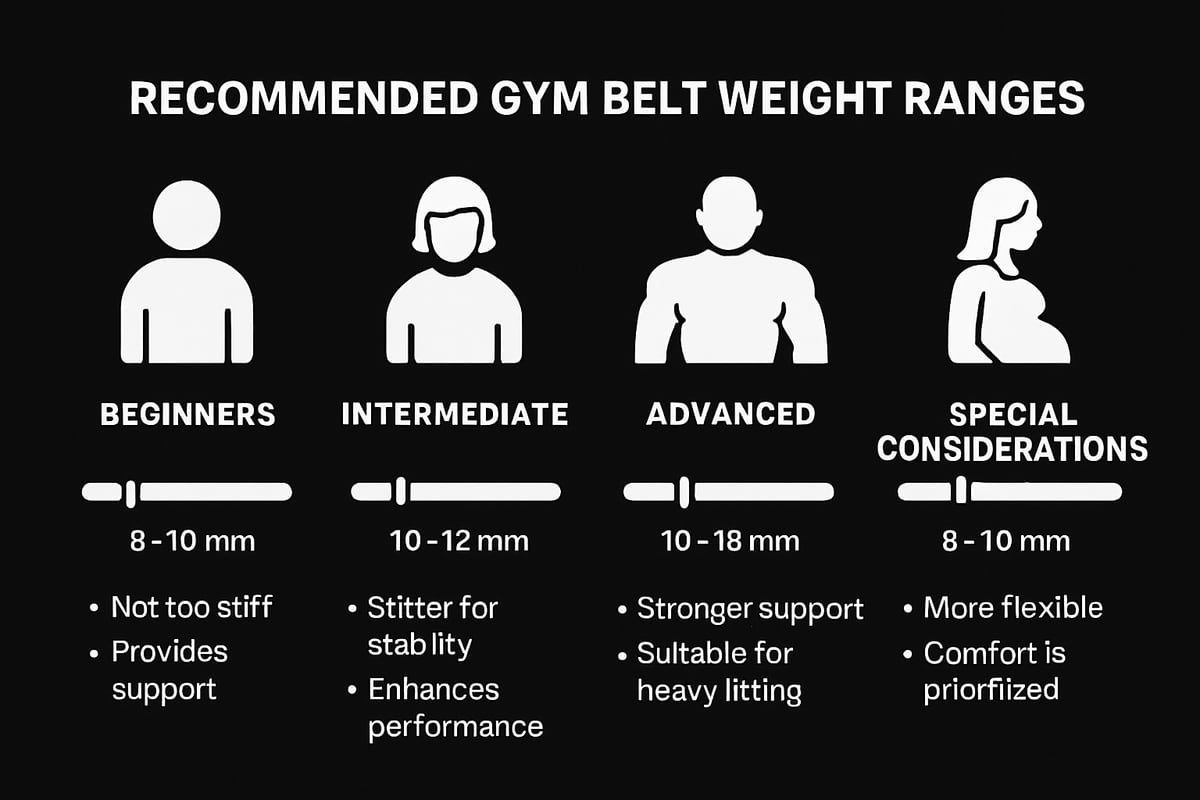
Beginners: Starting Safe and Building Confidence
For those new to the gym, selecting a lighter and more flexible gym belt weight is the safest route. Opt for belts in the 6mm to 10mm range. These provide enough support without sacrificing comfort or mobility during early training sessions.
Beginners benefit most from learning proper bracing technique before relying too heavily on any gym belt weight. Start by using the belt only for moderate to heavy lifts, focusing on form and breathing.
- Look for nylon or thinner leather belts with simple prong or quick-locking mechanisms.
- Seek adjustable sizing to accommodate early body changes.
- Read user reviews to find beginner-friendly options.
Remember, a lighter gym belt weight helps build confidence while minimizing the risk of developing poor lifting habits. Studies on biomechanical benefits of weightlifting belts show that even lighter belts can improve core stability for new lifters.
Intermediate Lifters: Balancing Support and Versatility
As your lifts progress, upgrading to a 10mm gym belt weight offers the perfect blend of support and flexibility. This thickness is ideal for lifters balancing strength and hypertrophy, or mixing compound and accessory movements.
Intermediate lifters often transition from basic belts to more specialized ones as training intensifies. A 10mm gym belt weight is versatile enough for squats, deadlifts, and even Olympic lifts, while still allowing mobility for dynamic movements.
Key features to look for at this stage:
- Enhanced durability for frequent training.
- Multiple adjustment holes or quick-locking systems.
- Trusted brands with quality stitching and materials.
Switching to a 10mm gym belt weight can help you push through plateaus safely, while still keeping your training diverse and effective.
Advanced Lifters and Competitors: Maximum Support for Heavy Loads
For advanced athletes, a 13mm gym belt weight is the gold standard. This extra stiffness and thickness provide maximal core support during the heaviest lifts, especially in powerlifting and strongman competitions.
When preparing for official events, always check federation rules for approved gym belt weight and specifications. Many top-rated lever belts meet these standards, offering unmatched tightness and support.
- Prioritize IPF or USPA approved belts for competition.
- Consider lever mechanisms for quick, secure fit under heavy loads.
- Choose reputable brands known for quality and certification.
If you want to dive deeper, Powerlifting Belt Insights offers an in-depth look at belt types and what advanced lifters should consider. For heavy squats and deadlifts, a 13mm gym belt weight is the trusted choice among elite athletes.
Special Considerations: Women, Youth, and Masters Athletes
Not every lifter fits the standard mold. Women, youth, and older adults often need a more tailored approach to gym belt weight. Tapered or contoured belts in the 6mm to 10mm range provide a better fit for smaller frames and increased comfort.
Youth athletes benefit from lighter, more flexible gym belt weight to complement developing bodies. Masters athletes, on the other hand, may seek added comfort and moderate support to protect joints and lower back.
- Look for contoured designs for better hip and rib fit.
- Adjustable sizing is crucial for growing youth.
- Studies confirm that the right gym belt weight can aid injury prevention and boost longevity in training.
No matter your age or gender, prioritizing fit and comfort in gym belt weight ensures safety and sustainable progress in the gym.
Expert Tips for Maximizing Belt Effectiveness and Longevity
Getting the most out of your gym belt weight means more than just strapping it on for every set. To truly level up your lifts, you need smart strategies that maximize support while preventing dependency. Let’s break down the pro moves that keep your gym belt working hard for you—work smarter, not harder.
Use Your Belt Strategically, Not Constantly
Relying on your gym belt weight for every exercise can limit your progress. Expert coaches recommend wearing a belt only for heavy, compound lifts—think squats, deadlifts, or overhead presses—where core stability is critical. This approach trains your body to brace naturally and saves maximum support for your toughest sets.
Master Bracing to Unlock Belt Benefits
A gym belt weight is only as effective as your bracing technique. Before a heavy lift, take a deep breath into your belly, press your core out against the belt, and maintain tension throughout the movement. This increases intra-abdominal pressure, stabilizing your spine and reducing injury risk. Many lifters notice immediate gains in strength and confidence when they master this skill.
Know When to Belt Up—and When to Skip It
Don’t wear your gym belt weight for every rep. Save it for lifts above 80 percent of your one-rep max or when fatigue sets in during high-volume training. For warm-ups, isolation movements, or mobility work, train without the belt to strengthen your natural bracing ability. This balance helps you build a resilient core while reaping the benefits of added support when it counts.
Prioritize Care for Lasting Performance
A well-maintained belt lasts longer and performs better. After each session, wipe away sweat and moisture, and store the belt flat or rolled loosely in a cool, dry place. For detailed cleaning and storage tips, check out this Weightlifting belt care and maintenance guide. Regular care preserves the integrity of your gym belt weight and prevents premature wear.
Avoid Common Mistakes and Troubleshoot Issues
Wearing your gym belt weight too high or too low can cause discomfort or limit its effectiveness. Make sure the belt sits snugly around your midsection, just above the hips. Avoid over-tightening, which can restrict breathing and movement. If you experience pinching or slipping, adjust the fit or try a different style. Most belts require a short break-in period, especially leather models—be patient as the material molds to your body.
Plan for Replacement and Monitor Durability
On average, a quality gym belt weight lasts two to five years with regular use. Signs that it’s time to replace your belt include excessive stretching, cracking, or a loose buckle. Track how your belt performs over time and don’t hesitate to invest in a new one if support starts to fade.
Enhance Support with Complementary Gear
For all-around protection, pair your gym belt weight with other supportive accessories. Wrist wraps and knee sleeves can stabilize joints during heavy lifts. If you’re unsure how to choose, this Choosing Straps for Weights resource breaks down options that work well with your belt for maximum lifting confidence.
By applying these expert tips, you’ll get the best out of your gym belt weight for years to come—stronger lifts, safer sessions, and less hassle in the long run.
Now that you know what to look for in a gym belt and how the right choice can seriously boost your safety and performance in 2025, why not take the next step? At Katamu, we make it easy for you to find a premium lever belt that fits your training style, goals, and personality—with top notch quality that’s built to last. Whether you’re just starting out or pushing for your next PR, you deserve support that works as hard as you do. Ready to upgrade your setup and feel the difference?
